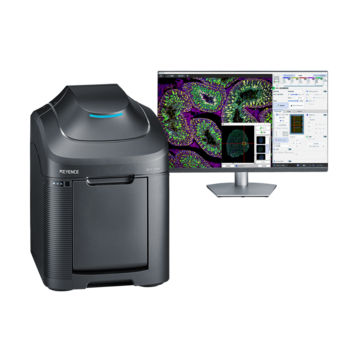Fluorescence Microscopes
BZ Series Contributes to Understanding the Pathological Model of Asthma
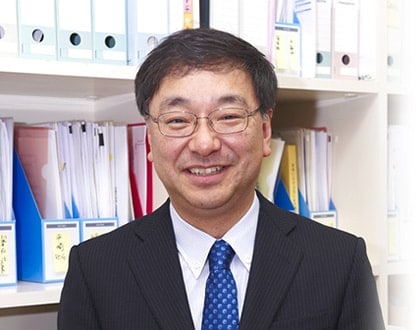
Dr. Toshinori Nakayama
Professor of Department of Immunology, Graduate School of Medicine, Chiba University
Medical Global COE Program Center Leader
Dr. Toshinori Nakayama was born in 1959 in Okayama Prefecture. He completed a doctorate program at the Graduate School of Medicine, The University of Tokyo in 1988. Starting out as Postdoctoral Fellow at the National Cancer Institute, National Institutes of Health (USA), he has been Research Associate at the Faculty of Medicine, The University of Tokyo; Associate Professor at the Research Institute for Biological Science, Tokyo University of Science; and Associate Professor of the Graduate School of Medicine, Chiba University; and in 2001, became Professor of the Department of Medical Immunology, Graduate School of Medicine, Chiba University. He took up his current post in 2004. Dr. Nakayama is concurrently the leader of the Medical Global COE Program, a position he has held since 2008. He has received many awards, including the 3rd Japanese Society for Immunology Award in 2000 and the 14th Abbott Japan Allergy Research Award in 2004.
Get detailed information on our products by downloading our catalog.
View Catalog

Immune system regulation to fundamentally change the way medical care is provided
Today, disorder treatment drawing on new research findings is seeing rapid progress as we understand more about how human immunity works. New treatment approaches have been considered from the aspect of the immune system for not only allergies but also for refractory diseases such as cancers and cardiovascular diseases. While research institutes worldwide are engaged in fierce competition in the R&D in this field, Chiba University has been seamlessly working on the entire process from the latest basic research to translational research that leads to clinical studies. Since fiscal 2008, the University has been promoting the Global COE Program as an international research hub for immune system regulation toward disease control. Spearheaded by Dr. Toshinori Nakayama, Professor of Immunology and leader of the center, Chiba University is focusing on the cultivation of able researchers and on research to overcome a range of refractory diseases. The efforts to establish advanced medical care are being undertaken at a rapid pace.
We’re here to provide you with more details.
Reach out today!

01. Chiba University as a frontrunner in the field of immunological disorder research
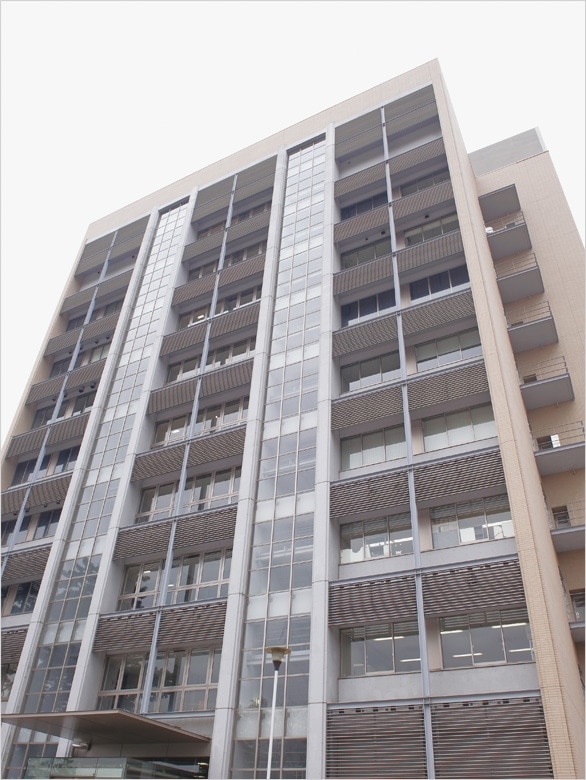
This Chiba University building for comprehensive medical and pharmacological research accommodates the Global COE research center.
Modern immunology began when Edward Jenner in England developed smallpox vaccination for the prevention of smallpox about two centuries ago. Through the achievements of other past greats—including Louis Pasteur, Robert Koch, and Kitazato Shibasaburo—immunology has seen significant advancement and the human race has overcome infectious diseases one by one, making them threats of the past.
The human body has biological defenses—excellent mechanisms that protect against pathogens that enter the body. There are two types of biological defense: innate biological defense (natural immunity) that people are born with, which includes white cells taking in and decomposing pathogens, and adaptive biological defense (acquired immunity) whose function it is to learn to combat pathogens that innate immunity cannot respond to.
With the latter, the immune function recognizes bacteria and viruses that invade the body and memorizes that information to prepare resistance for the next invasion by the same pathogen. Among the cells involved with immunity, there are macrophages (which ingest antigens and present information on them), B cells (which produce antibodies), and T cells (which present antigen information received from macrophages to B cells).
Nowadays, basic research on the immune system has progressed significantly, and we are gaining a clearer understanding about the functions of individual immunocyte types. As we learn more about these cells, immune system-based treatment approaches to disorders are coming into the spotlight. For example, with respect to rheumatoid arthritis, findings from immune system research have brought about innovative therapies that are now in wide use. Even for diseases that were conventionally considered incurable, paths toward treatment are starting to open.
Research institutes across the globe are working on new discoveries about the immune system and applying findings to treat diseases, and Chiba University is one such institute engaged in cutting-edge research. Here, the Graduate School of Medicine and the Graduate School of Pharmaceutical Sciences are working on basic research concerning the immune system mechanisms and are aiming to, on the basis of this basic research, establish a therapeutic concept for refractory immunological disorders.Additionally, the Center for Advanced Medicine, which opened in 2008 on the premises of the University Hospital, promotes clinical studies aimed at providing evidence for the therapeutic concepts developed from the findings from basic research.
According to Dr. Toshinori Nakayama, who is a professor of immunology at the Chiba University Graduate School of Medicine, the University has its eyes on the treatment of refractory immunological disorders that are not permanently curable with conventional medical care. The range of diseases is broad and includes allergies, cancers, vasculitis, and arteriosclerosis. Dr. Nakayama gives his view on enhancing research establishments at Chiba University as follows:
“The Graduate School of Medicine has celebrated its 60th year as part of Chiba University and more than 130 years of history including its time as the preceding institution, Chiba Medical University. The Graduate School of Medicine has been working on research into immunity and allergies from early on, with experts in each field working on the latest research, ranging from basic to clinical, in mutual collaboration. In the clinical area, professors specializing in immunological disorders are taking posts in the departments of pediatrics, internal medicine, dermatology, and otology. Each of these professors is engaged in efforts to develop new therapeutic approaches, making the School a major hub for pursuing advanced treatment of immunological disorders.”
We’re here to provide you with more details.
Reach out today!

02. Dr. Nakayama’s challenge for cutting-edge research to understand immunological memory
As a leading expert in the basic research in the field of immune system formation, Dr. Nakayama has contributed to uncovering the basic principles and mechanisms of acquired immunity.T cells, a type of immune cell, are known to differentiate into helper T cells. Dr. Nakayama has provided an explanation to the functions that these cells have.
As his new research theme, Dr. Nakayama is working on understanding, at a genetic level, the mechanism of how helper T cells, such as Th1 and Th2 cells, differentiate into memory cells. Dr. Nakayama says, “While we have expanded our knowledge of acquired immunity, there are yet more unknown facts. How immunological memory forms—the essence of acquired immunity—is hardly known, and as a researcher, I want to get to the bottom of this mechanism at molecular and genetic levels. These research findings will likely and eventually lead to a permanent cure for allergies and the development of influenza vaccinations that can be effective for a lifetime with just one injection,” explaining the significance of the research theme.
On the foundation of many years of basic research, Dr. Nakayama is also working on applied studies aimed at immune cell therapy. One of those studies is research into an innovative therapy using NKT cells, referred to as the fourth lymphocyte following T cells, B cells, and natural killer (NK) cells. This therapy is anticipated to be effective in cancer treatment. In particular, a clinical trial started in around 2001 for lung cancer, producing significant treatment outcomes such as shrinkage of cancer tumors. Application of this method is also under consideration as a treatment for head and neck cancer. An application in these fields is the first step toward the application of the treatment on a wider scale.
“Conventional standard surgeries, radiology, and chemotherapy had limits with regards to lung cancer. This is because lungs are an organ with a sponge-like structure and have a large amount of blood flow, so that by the time the cancer shows up as a shadow on a CT or on other diagnostic imaging, it is often many tiny metastases (less than a few millimeters) inside the lungs. Those eventually grow and cause the lung cancer to recur. Without lungs, humans cannot breathe and will die, so we cannot preventively resect the entire lungs like a full gastrectomy in the case of advanced stomach cancer. There is a limit to controlling cancer cells with drugs.
In that sense, treatment using the patient’s own immune system is promising. Even compared to other treatments such as post-surgery chemotherapy, there is already evidence of patient life expectancy being extended significantly. Currently, we are conducting clinical trials to verify the regimen and dosage of NKT cells while steadily advancing the research on the therapy. Preparation for application as advanced medical care is also in progress, and today we have about 100 patients receiving the therapy.”
There are hopes for the effectiveness of the treatment of cancer using immune cells. Furthermore, this treatment has a great advantage in that it is safe and minimally invasive. “Unlike existing anticancer drugs, this approach is characterized by it being less traumatizing to patients. Side effects are generally just a slight fever, if any,” says Dr. Nakayama.
As to what he expects the future of this research to be, he states that “immune system-based therapy will make possible a permanent cure for cancers as custom-made medical care and will greatly change the way medical care is provided, shifting from cancer treatment to prevention.”
As another new approach following treatment for allergies and cancers, Dr. Nakayama is also thinking about treating cardiovascular disorders, including arteriosclerosis, from the perspective of the immune system. According to Dr. Nakayama, “treatment using the immune system will be possible by framing arteriosclerosis as an inflammation inside a blood vessel.” He says that he “wishes to put more efforts into cultivating researchers in this field alongside working on joint studies with researchers specializing in arteriosclerosis and inflammation in the blood vessels, with a vision of where things can be 10 and 20 years down the road.”
We’re here to provide you with more details.
Reach out today!

03. Developing an international research hub with the Global COE Program
Chiba University is promoting the Global COE Program, for which Dr. Nakayama has served as the center’s leader since fiscal 2008. The program is designed to be an international research hub for immune system regulation toward disease control. The center consists of the Graduate School of Medicine, the Graduate School of Pharmaceutical Sciences, the University Hospital, and the following external institutes: the RIKEN Research Center for Allergy and Immunology and the National Institute of Radiological Sciences. The research center conducts research on the immune system and aims to achieve therapeutic research and development for refractory immunity-related diseases by means of regulating the immune system. As an educational institution, the Global COE Program at Chiba University is also focusing its efforts on cultivating young researchers engaged in immunology research.
Looking at the role of each organization, while the two Graduate Schools at Chiba University are engaged in research on therapeutics based on acquired immunity, RIKEN works on therapeutics based on natural immunity. Conventionally, research on immunity was centered on acquired immunity, but the importance of natural immunity has been reaffirmed in recent years. Through close collaboration, the research performed by Chiba University and RIKEN has advanced therapeutics based on both immune responses.
As for clinical studies, in addition to the University Hospital undertaking clinical trials on immunological disorders led by the Center for Advanced Medicine, the National Institute of Radiological Sciences is working on the development of combination therapies that use both immune responses and charged particle therapy to combat cancer. The center’s use of this combined therapy is a worldwide first and it is anticipated to be beneficial as a less invasive therapy for cancer.
“Japan, the U.S., and Europe are on par with each other regarding research into the immune system. In pursuit of being a global frontrunner in this field, this is an ideal environment. While we promote the Global COE Program, we can deliver new therapeutic concepts to the world as an international education and research hub for immune system regulation toward disease control,” says Dr. Nakayama.
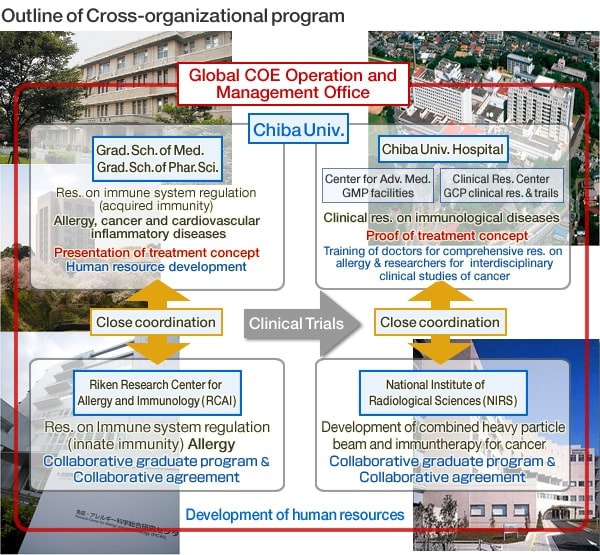
Organizational structure of the Global COE Program “International research hub for immune system regulation toward disease control”
(Source: Chiba University Global COE Program Website
https://www.m.chiba-u.jp/class/gcoe/eng/outline/)
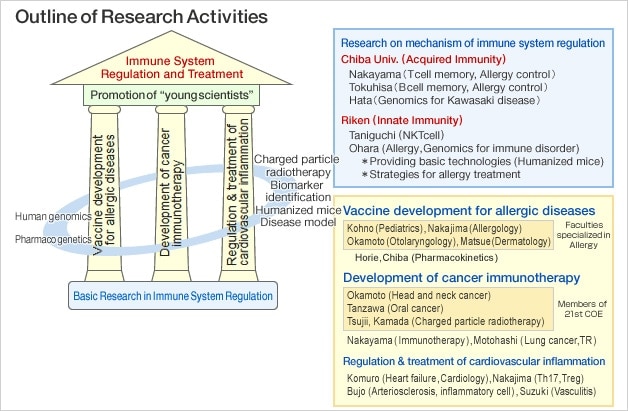
Outline of Global COE Program research
(Source: Chiba University Global COE Program Website
https://www.m.chiba-u.jp/class/gcoe/eng/research/)
We’re here to provide you with more details.
Reach out today!

04. BZ Series contributes to understanding the pathological model of asthma
Suited to a research center adopted for the Global COE Program, Dr. Nakayama’s lab is equipped with the latest cell separation systems and other equipment necessary for research into the pathological models of immunological diseases. Among such installations, the KEYENCE BZ Series fluorescence microscope is used to its full potential for cell observation.
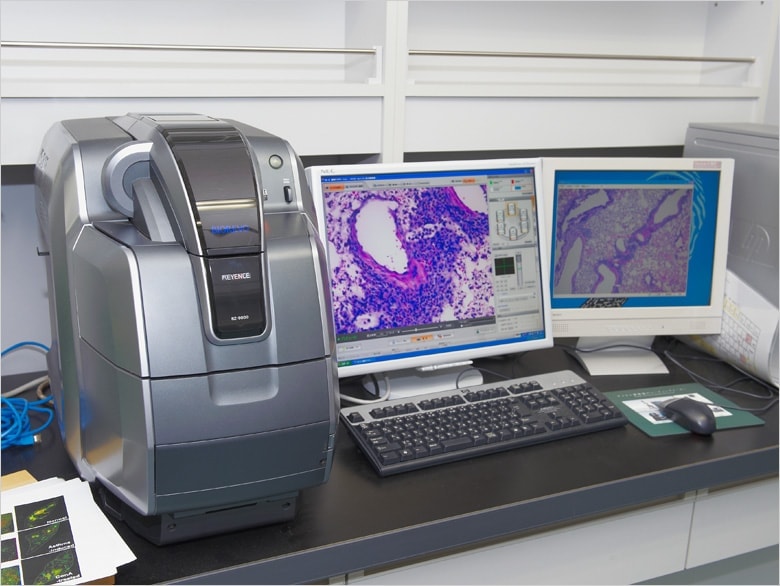
KEYENCE BZ Series fluorescence microscope installed in the laboratory
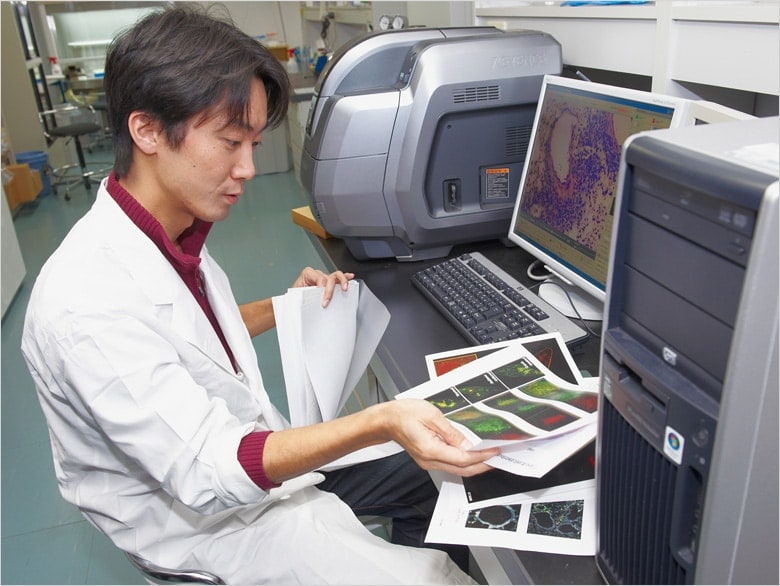
Dr. Chiaki Iwamura observing mouse lung cells using the BZ Series
“I had a strong impression that fluorescence microscopes were generally only useful to people with special skills, but the BZ Series has the great advantage that anyone can use it, even when they do not have much experience. It is excellent in the sense that it is easy to use even for people with limited opportunities to get to know microscopes due to time restrictions, a good example of this is physicians involved in clinical research,” says Dr. Nakayama.
Assistant professor Chiaki Iwamura is one of the most frequent users among the lab staff. Currently, he is dedicating himself to allergy research, particularly the pathological model of asthma using mice. What is important here is detailed observation of the lungs and bronchi. Dr. Iwamura says that he uses the BZ Series for magnified observation and photography.
“Conventionally, observation with a fluorescence microscope was done in a darkroom, but long hours of such observation was hard on the eyes. In contrast, KEYENCE’s BZ Series does not need a darkroom, so we can concentrate on observation for a long time.”
To observe pathological models of asthma in mice, one needs to view the entire lung as well as enlarge key parts for observation. The BZ Series’ navigation system function comes in handy for such uses. It can display magnified images of any part of the entire image captured with a low-magnification lens when the user just clicks that part. Dr. Iwamura details the advantage provided by using the BZ Series, “With other microscope models, observation takes too long and there were a lot of wasteful aspects, but with the BZ Series, you can easily see the part you want to see.”
Most of the photographs for the papers he prepares are taken with the BZ Series. “The picture quality of the photos can have an influence on how convincing the paper is. For that reason alone, it pleases me to be recognized as having clear pictures,” he says.
Dr. Iwamura mentions, “While there are still a lot that is unknown about the mechanism of allergies, we are learning more at a molecular level.” His future goal is to seek basic research that contributes to permanent cures for atopic dermatitis and other allergic problems. As a member of the Global COE Program, Dr. Iwamura is engaged in frontline research on the immune system while ardently instructing several graduate students and deepening exchanges with researchers abroad.
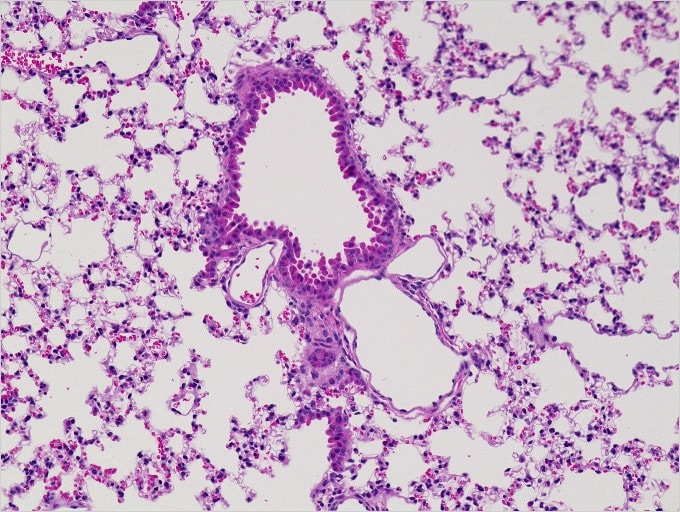
Normal mouse lung (stained with H&E). All four photos are taken using a KEYENCE BZ Series fluorescence microscope. 200x
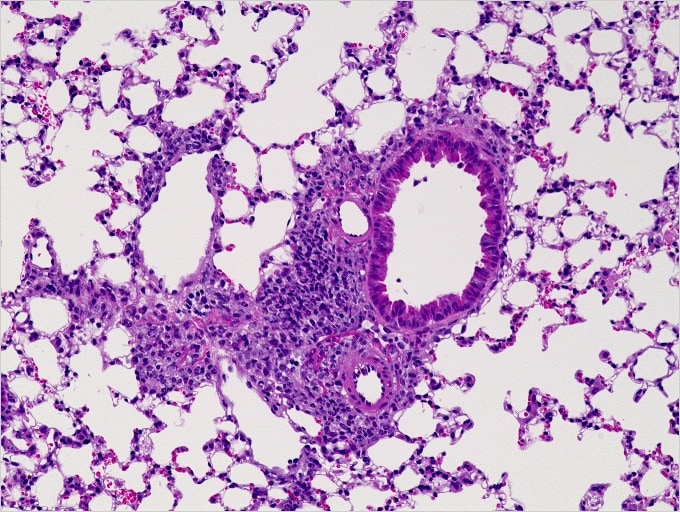
Lung with asthma symptoms. While infiltrating immune cells can be observed, the types of immune cells cannot be identified with brightfield observation. 200x
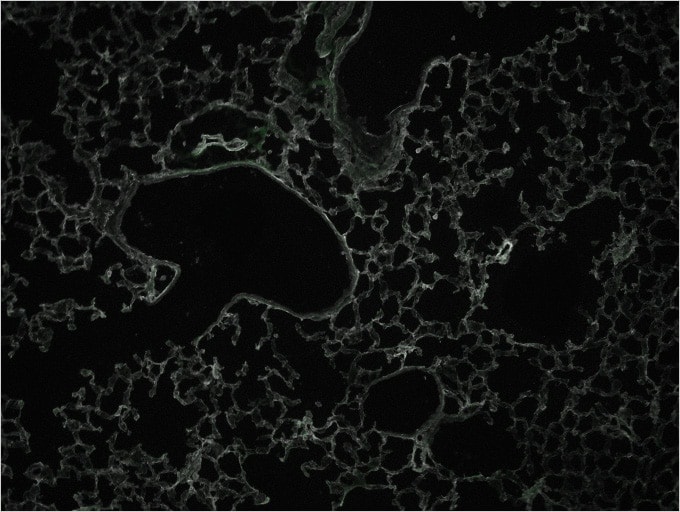
Normal lung stained with immunofluorescence. 100x
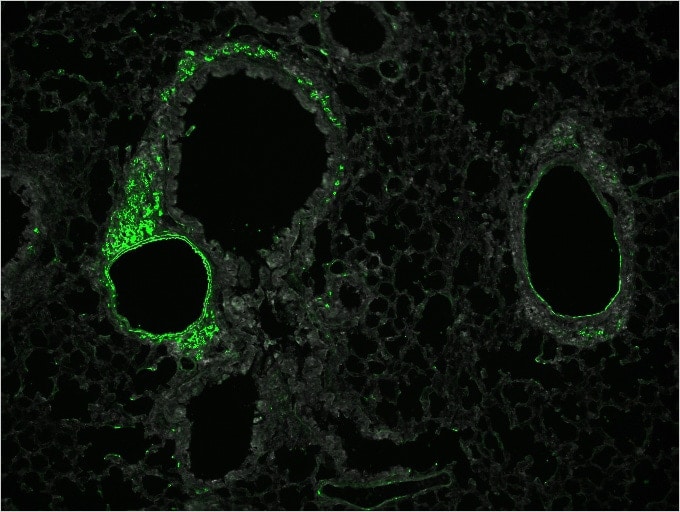
Lung with asthma symptoms stained with immunofluorescence. Localization can be observed by staining with a T cell marker. 100x
We’re here to provide you with more details.
Reach out today!

05. Growing expectation for the participation of young researchers in the field of immune system regulation
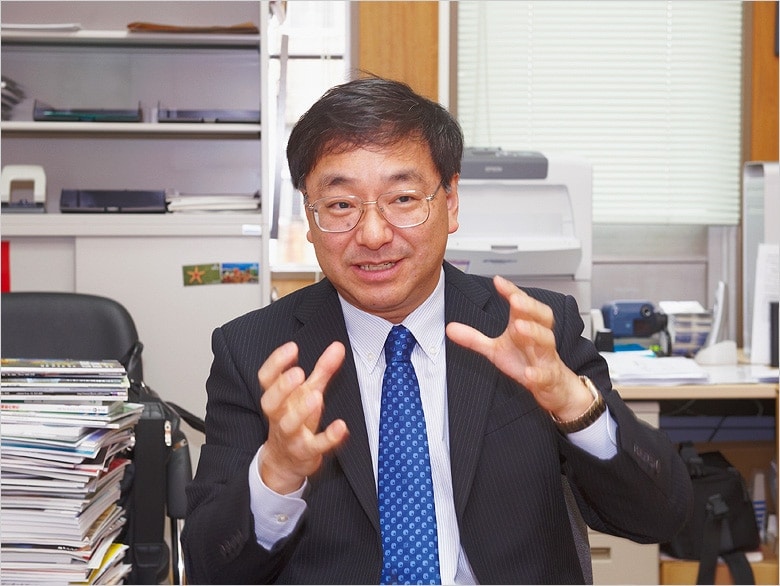
Dr. Nakayama fervently talks about the future potential of immune system research
Dr. Nakayama’s therapeutic approach to refractory diseases based on the perspective of regulating the immune system is now about to lead the world. Having said that, as he puts it himself, “there is still much unknown about the immune system mechanisms,” and we are waiting for future research results to come out. In light of this, Dr. Nakayama shows his enthusiasm for the Global COE Project as “wanting to cultivate as many young able researchers as possible.”
“If you are aiming to be in the top class in a field globally, what is most important is to do research in a group that is at the forefront of the field. In such an environment, I would like them to keep thinking around the clock, speaking in the extreme. Being totally engrossed in research to the extent that you are seeing your research theme in your dreams will lead the way.”
Dr. Nakayama himself joined medical research upon becoming acutely aware of just how many refractory diseases there are during his student days. “Of course it is important as a clinical physician to work on diseases that can be cured, but on the other end there are incurable diseases. Wanting to do something about these is what got me started as a researcher.”
Research grants are being reduced nowadays, making it more difficult for young researchers to continue research, but Dr. Nakayama explains the importance of pursuing a research theme without taking an easier way around.
“An opportunity to take a giant step forward will come to everyone some day. I would like them to be fully prepared when that time comes. For example, they need to have good language skills for studying abroad since exchanges with overseas researchers will be important in the future. The constant daily prep work they perform will lead to them making great strides as researchers.”
(As of March 2009)
We’re here to provide you with more details.
Reach out today!

<General knowledge> Immune cells (Immunocytes)
All immune cells originate in the bone marrow and are produced from stem cells to become macrophages, T cells, B cells, natural killer (NK) cells, and other white blood cells. B cells further become antibody-forming cells, which produce antibodies that fight antigens.
T cells differentiate into helper T cells and killer T cells. The former gives instructions to B cells to produce antibodies and to killer T cells to attack antigens.
In a healthy person’s blood, lymphocytes account for about one-third of the white cells. Most of the lymphocytes are T cells, B cells, and NK cells, but NKT cells also exist in a very small percentage of below 0.1%. This is said to have an important role in the immune system.

